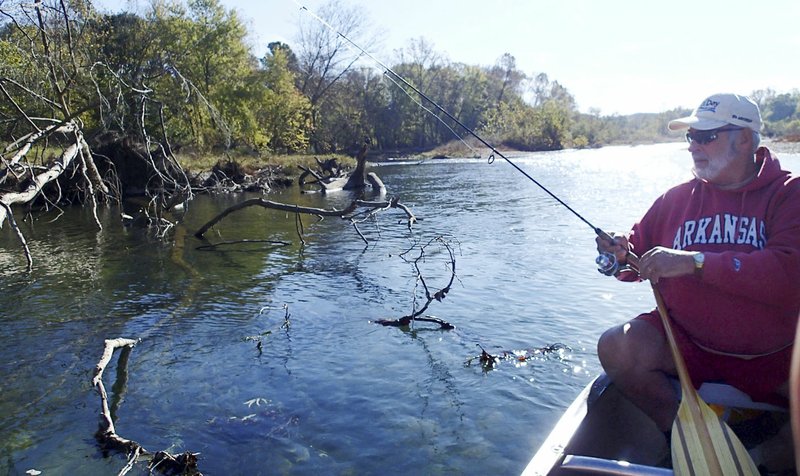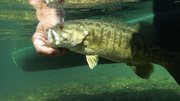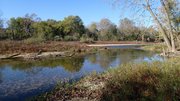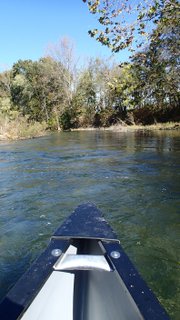A warm breeze in November is a siren song that calls for one last float trip before winter.
Bob Ross of Rogers sported a pair of red shorts while sliding his canoe into the Elk River in southwest Missouri on a warm and sunny Veteran's Day, Nov. 11. The Elk promised a fall foliage float, with smallmouth fishing to boot, on this clear, beautiful stream.
Downstream on the Elk
Paddlers can choose a long or short float on the lower Elk River. A 10-mile float starts just below the low-head dam at Noel, Mo. and goes to the Cowskin Access. A float of three miles is available through Cowskin Canoe Rental, located at the Cowskin access where Missouri 43 crosses the river. The float starts on private property and ends at the access.
The Elk River is a Class I stream that is easy to navigate and suitable for novice paddlers.
Information: Cowskin Canoe Rental, 417-775-2448.
This was the Elk River, all right, but not where most paddlers float. Most ply the river in the Pineville, Mo., area, but we were far downstream on the lower end of the river, about 10 miles west of Noel, Mo., almost in Oklahoma.
The game plan was to meet Larry Doyle, owner of Cowskin Canoe Rental, at the river. He piled into the pickup and directed us to a piece of private property he leases three miles upstream from the Cowskin public access at the Missouri 43 bridge. Doyle would drive the pickup back to his place at the bridge. We'd take our time floating back to the pickup.
This is a quiet stretch of river, even during the peak summer floating season.
"You could even float here on a weekend, and you might not see another canoe," Doyle said.
The smallmouth fishing is good here, he added, as it is everywhere on the Elk.
Shoreline hardwood trees showed some rust color in their leaves. Sycamore trees had the most color, showing bright yellow. Kingfishers flew upstream and cackled a noisy song. Ross dipped his paddle into water so clear it's almost transparent.
"I don't think you can go anywhere on the planet and beat an Ozark stream," he said. "We're so lucky to have them."
Autumn has been dry, but the Elk had plenty of water for floating this far downstream. Most of the shoreline is forest as the Elk meanders its way west, eventually flowing into Oklahoma's Grand Lake. The stream is wider and shallower here than it is upstream between Noel and Pineville. Deep holes are rare. There's plenty of timber and rock in the water that are the lairs of smallmouth bass, Ross's target fish.
He fished from the stern of his 17-foot canoe, outfitted with seats that have back rests. He cast a small plastic worm while his buddy in the bow fished a green tube bait. A half hour into the float, a 15-inch smallmouth chomped on the tube.
Six-pound test line sliced through the clear water. The fish fought like one twice its size and bent the rod clear to the handle. The 15-inch fish was the epitome of an Elk River smallmouth and hopefully a clue of good fishing to come.
Another mile of river slipped by before Ross caught the next smallmouth. The tally at the end of the float was only three smallmouth bass, not like the 50-fish days enjoyed on the Elk River during summer. The water temperature was around 60 degrees, maybe 20 degrees cooler than midsummer.
"It's funny how you can catch big smallmouths at Beaver Lake when the water's cold, but these stream smallmouths seem to shut down," Ross said.
Fall floating can be beautiful, but bites can be few in the cooling water. It's a scenario other stream anglers such as Kenny Stroud of Siloam Springs know well. He does most of his stream fishing on the Illinois River using tube baits and plastic worms in the summer. He switches tactics when the water cools.
A jig and pig is his lure of choice. Stroud likes a marabou (hair) jig with a Zoom Critter Craw on the hook. The set up imitates a crawdad, a rib eye steak to a smallmouth bass. Stroud also uses a one-quarter-ounce spinner bait, cranking it in slowly. Gray or purple are his favorite colors, or chartreuse if the water is dirty.
This downstream part of the Elk River is a haven for anglers who like to wade. Eddy Silcott of Rogers gets knee deep in the Elk during summer. He parks at Cowskin access and doesn't wade far.
"Fishing is actually the best right there, or within 200 feet on either side of the access," he said.
Silcott uses soft-plastic lures, including tube baits, plastic craws and soft jerk baits.
"I think just about anything that has some action will knock the socks off those smallies when they're really biting," he said.
Like floating, wade fishing the Elk is best when the water is warm. A trip to Cowskin access might be one to pencil in for next spring and summer.
Flip Putthoff can be reached at [email protected] or on Twitter @NWAFlip
Sports on 11/29/2016




